If you have skunks around your home, you already know what a pest they can be. Along with their spray having a very strong and displeasing odor, skunks can cause serious property damage.
Skunks will spray in order to defend themselves if they get startled or hurt. Typically, it’s wild skunks and their young, called kits, that are quick to do this, as they startle easily. Musk is the word used to describe the very pungent scent that skunks release if they feel threatened or injured.
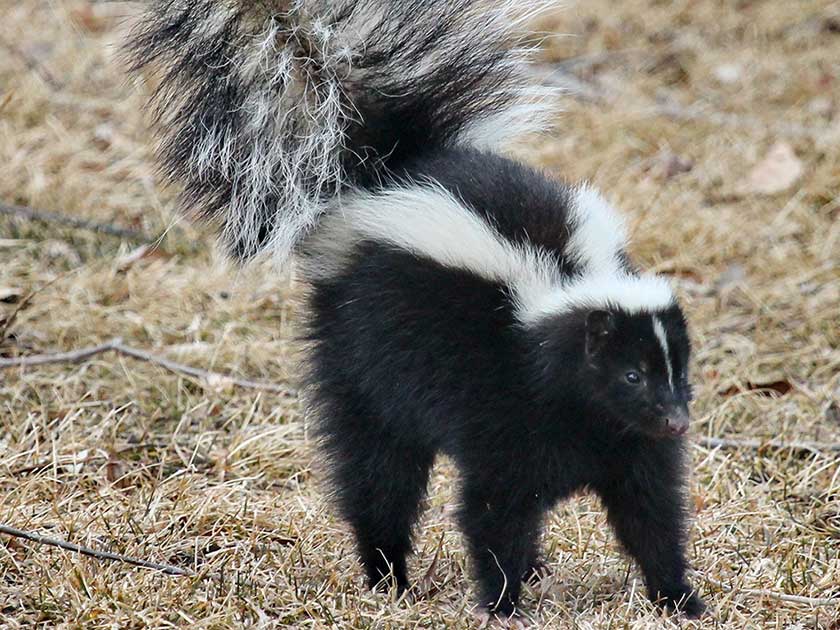
They use their spray to fend off predators or perceived dangers. Skunks can be especially problematic if you have pets around, as it’s very common for pets to be sprayed.
Luckily for you, skunk control is rather easy if you know the right techniques. In this guide, I’m going to show you exactly how to get rid of skunks using proven methods.
Here are the Best Ways to get rid of Skunks
1. Solar Lights to Repel Skunks
Skunks, as night animals, are extremely sensitive to light. Solar lights are a great way to deter night animals from coming onto your property. The lights are safe, environmentally friendly, and weatherproof in most cases.
The solar lights flash repetitively all night, every night. They are automatic and do not run on a motion sensor, which means they will keep constant guard of your property all night. The solar light devices should be placed at eye level with the animal to be most effective.
What happens to a skunk, or any night animal, once they see the flash is that it triggers their fight or flight survival instincts because they see it as an ‘eye’ and interpret it as being seen, which is their greatest fear. They believe they have been spotted by a predator and will be pursued, so they run.
The skunk will scatter on instinct under these circumstances, as it believes it must, in order to survive. Often this works well paired with a few of the other methods listed.
Predator Eye Nighttime Solar Powered Animal Repeller
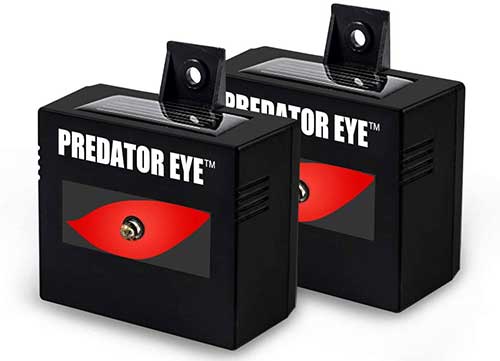
Nighttime Solar Powered Skunk and Animal Repeller by Pest Soldier comes as a 2pk. 100% Eco-Friendly product and 100% Guaranteed. The product is waterproof and deters light nocturnal animals, including skunks. Protect your home, field, and livestock from night animals by using Nighttime Solar Lights. With a solar-powered battery, this product will naturally charge during the day so it will be able to run all through the night. Not only does this product manage skunks but it is useful in preventing other pests, such as coyotes, foxes, wolves, deer, cats, and cougars. This product will automatically turn on at dusk and off at dawn. The predator can be stopped from at least 500 yards. There are 2 devices included in the package for complex area coverage. As a bonus, the flashing red light can fool criminals into thinking your property has a security system.
2. Traps (Skunk Proof Preferred)
Traps are a great way to get rid of skunks. There are many traps on the market to choose from and that will be your first task to do. Choosing your trap. Trapping animals yourself can save you a lot of money in the long run and rehoming these animals is more humane. Keep in mind that the traps should be on a level surface for the best effect. Placement should be where you have previously discovered his pathway.
Use cat food as bait. Most skunks will show interest with cat food, oyster mushrooms or any mushroom, fresh vegetables, and fish. Place the food well within the trap so the skunk needs to enter all the way. Position the skunk trap in a way that will easily let the skunk enter the trap and keep you from facing his rear, just in case. Usually, traps are cages and have a lifting door with a lock to hold it up until the skunk enters and then falls quickly once it comes into the trap.
Tuff Trap – Spray Proof Skunk Trap
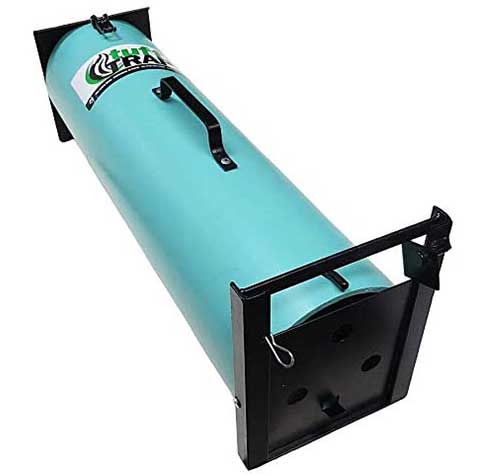
Tuff Trap Spray Proof Skunk Trap is ideal for rehoming skunks as they cannot possibly spray while in this trap. The trap’s design prohibits the skunk from being able to raise its tail, or arch its back and it is unable to see out so it is not likely to be startled into even needing to spray. Skunks can be easily transported using this trap and it’s great for use on the farm, around the yard, in the garden, and under the porch or shed. The build of this product is awesome but the greatest feature is the guillotine style door on it. This allows you to place the trap right up to the hole so the skunk has no choice but to go inside. This product comes with a five-year limited warranty.
3. Standard Live Trap For Skunks
Havahart 1079 Large 1-Door Humane Animal Trap for Raccoons, Cats, Groundhogs, Opossums
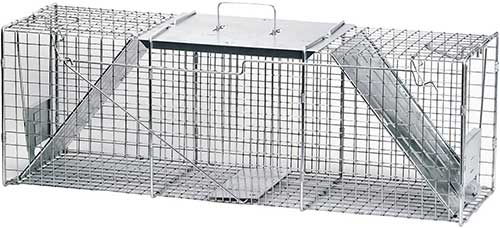
Havahart 1045 Large 1-Door Humane Animal Trap is the humane way to trap and rehome. It’s ideal for capturing raccoons, cats, woodchucks, armadillos, skunks, and other small-sized pests. It’s rather large at around 32in x 13in and has one spring-loaded solid metal door. This allows for capturing the animal at minimal risk to the animal. The edges are smoothed on the inside to add to the animal’s safety. This product was designed for high catch rates and few escapes. It’s not likely to rust or corrode and comes fully assembled and ready to use. The trigger rod is on the outside of the product so the animal can’t damage it while inside. Made in the USA.
Skunk Trapping Tips
- It’s a great idea if you are going to trap and relocate the skunk, that you consider transportation. It’s not wise to transport a trapped skunk inside your car. If you have a friend with a pick-up truck to transport the skunk, that is your best bet. This way you can avoid the skunk spraying in your car. Having to ride around town with musky skunk smell in your car will be awful!
- Any time you approach a skunk trap, go very slowly to avoid scaring thing skunk and having it spray.
- Once the skunk is caught, you’ll need to approach the trap very carefully. Take a tarp or blanket to cover the trap in order to avoid being sprayed. Use the tarp or blanket as a shield for yourself until you have the trap and skunk covered. After it’s covered, it is safe to lift the cage and put it in the back of the vehicle you will use to transport.
- It’s a good idea to approach the skunk inside the trap from the side. If you approach it from the front or the back you risk startling it and having it spray. Slowly approach from the side.
Questions to answer before you buy or set up a trap for small animals
- Check your local laws to be sure you can trap and transport your local animals. If any animal is euthanized, be familiar with the laws in your county.
- Do you know how to dispose of the dead skunk legally?
- Do you know how to release a trapped skunk?
- Are you prepared to kill the skunk if needed?
- Do you know what bait to use for skunks?
- Do you know how often to check a skunk trap you’ve set?
Related Article: 12 Best Ways To Get Rid of Raccoons
4. Red Fox Urine Skunk Repellent
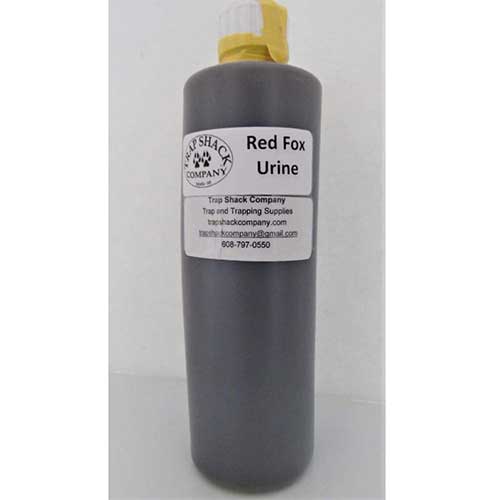
Using Red Fox urine as a cover scent to deter skunks is very effective. Distributing generously around the yard and in places or points of vulnerability for the skunks to enter. This will need to be reapplied weekly. If it rains, it will need to be reapplied. Trap Shack Co. Red Fox Urine is a natural, non-lethal deterrent for small night animals. This product is not effective for deterring squirrels, fox, or coyotes and may actually be attractive to them. Very easy to use with gloves and it’s recommended as it has a very powerful odor.
While this probably isn’t the most glamorous method to use, it is very effective when coupled with other methods. In addition, distributing predator urine (fox urine in this case) around the yard and its parameters is useful in deterring skunks, and other night animals. Once they smell the urine of their predator, they steer clear immediately. The only trick is that it may need to be reapplied daily or every few days. Also, if it rains, it will need to be distributed again. It’s best to use this method along with a few of the other methods listed.
5. Fences for Skunks
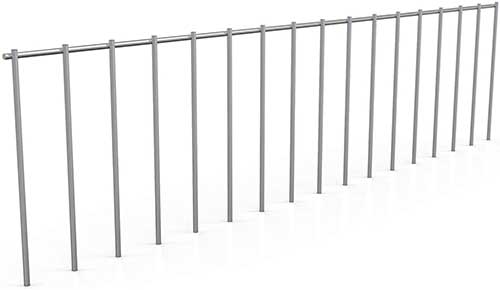
Do skunks climb? That is the question on everyone’s mind. Who hasn’t built fence upon fence trying to get this pesky critter out of their yard? Well, the answer is Yes. Skunks can climb and are pretty good at it. They do prefer to burrow so only in extraordinary circumstances will they go over a fence but it has been done. However, even with this reluctant ability, skunks cannot climb over very high fences. On average, a fence of about 18″ or so. So, if you put up 6-foot fences around your property you are probably safe from catching any skunk climbing over your fence. Still, one thing to note, just because they are poor climbers does NOT mean they cannot dig.
When installing your fences, it will be necessary to bury a part of the fence underground to avoid the skunk digging under your newly installed fence for entry to your home or property. If you bury the fence approximately 6-8 inches and shaping into an outward-facing L at the base, a leg extending 8-10 inches back. This way it will be more difficult for them to dig under the fences and even if they do go that deep, they will have a long way to go backward to make it under. It’s not likely they will go to this length to get under your fence.
Deter or Relocate Skunks
Keep in mind that deterring and/or relocating skunks is the most humane way to get rid of skunks. There are a number of methods to achieve humane skunk removal, as mentioned. In most cases but not all, it is effective to use these skunk deterrent methods in combo with one another. For example, using the Urine with the Noise or Light solutions is usually effective and very inexpensive. Traps are also great and can be used to help in rehoming skunks effectively.
Follow the methods for prevention and should you need to remove or rehome an adorably stinky skunk or skunk family from your property, apply any and all of the skunk deterrent solutions listed above.
Related Article: 9 Best Mole Traps
Prevention Methods and Tips
Nine times out of ten, skunks have come around to your property looking for food and shelter. If you have chicken coops, backyard gardens or farms, vineyards, or any other sources for food, they have come to feed. They eat berries and insects which they will easily find all over the ground of your property. If they don’t find it on the surface, they will dig and dig little holes in the topsoil to find their food. There are a few ways to make your property a little less desirable and send those furry little stinkers off in search of another home and food source.
Skunks Diet and Burrows
- Skunks eat fallen berries, fruits, seeds, as well as, insects. They are a delicacy for skunks. If you have any fruit trees in your yard, make sure to clean up the ground below regularly removing the dropped fruit and seeds. This will dramatically reduce the skunk appeal of your property while also keeping the insect load light on your property as they love the sweet treats too.
- Skunks love to burrow under woodpiles, leaves, junk piles, or old logs. Any type of debris is a potential shelter for skunks. Clean out the debris and junk from your property. If you have old cars, tractors, or any junk lying around, get rid of it as soon as possible. You will first see the skunks leave or better yet, pass by your property altogether.
- Make sure to sweep up and bag your leaves and get rid of any junk. Skunks love to make their burrows under piles of leaves or anywhere inconspicuous. Cleaning out these potential areas is the best thing you can do to ensure the shy skunk doesn’t come anywhere near your home to set up his or her home.
Seal Up Old Skunk Burrows
- Fill abandoned burrows with gravel and use lids for the garbage cans. Before taking this step to fill the burrows, it is a good idea to be sure you are not trapping in skunks who still live in the burrows. To test, find the burrows you think are empty and put some leaves on top of it. In the morning, check to see if the leaves have been moved. If not, then the skunks have moved on and it is safe to fill the abandoned burrows with gravel. Otherwise, it’s time for a different strategy. Always a good idea to keep garbage cans tightly sealed with lids to protect from not only skunk entry but other small animals as well.
- Seal up any access points to sheds, basements, or underneath porches. Many times, no matter how well our house, shed, or porch is constructed, there are gaps in the build. These gaps are great entry points for skunks and other small animals. Filling them in is an effective defense for your home and property.
- As they are sensitive to noise, consider running a radio during the night to keep them away. It shouldn’t need to be too loud to deter the skunks from coming around.
Related Article: 12 Best Squirrel Proof Bird Feeders
Information on Skunks
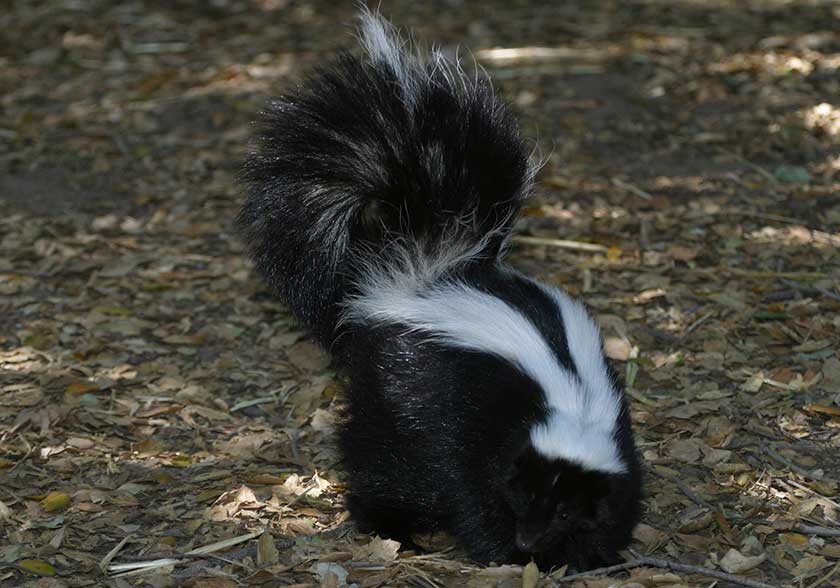
Most wild skunks will find their way onto your property when the weather starts to get cooler. Like the rest of us, they want a warm, safe place to sleep. However, when that warm, safe place is under or inside your house, you have a serious problem on your hands. Skunks can tear up a yard and dig away at your foundation trying to create their burrows or find their warm place to burrow. They like to live under porches, sheds, and they build burrows easily in those places.
Skunks are nocturnal animals and are very sensitive to light and sound. This means they are awake and hunting at night. They typically live in burrows they’ve dug underneath your porch, shed, or home. A burrow is a small tunnel that skunks dig out to make a home for themselves and their kits. Skunks usually breed in the Spring and the mother skunks care for their kits until Fall. If you are planning to rid your property of skunks, it’s best to do so before breeding season starts in the Spring. Otherwise, you will have to live with a family of skunks for the season.
This is primarily because most mother skunks will endure almost any control method while caring for their kits. They have anywhere between 2-10 kits in a litter. If you decide to approach the mother and her kits, please keep in mind that the kits will likely spray anything that surprises or scares them. In fact, since they are new to their ‘powers’ they will spray for seemingly no reason at all at first.
How do you know if you have skunks at your house?
Skunks are hard to see at night but if you check during the day there are tell-tale signs that a skunk has been lurking around your home attempting to make it his or her home.
Skunks make holes in yards because they are looking for food. Sometimes if they can’t find seeds or fruits on the surface, it’s there just below the topsoil to be found. They eat insects, berries, and vegetables. Sometimes you can use fish as bait as well in the traps. You are likely to find their empty burrows around your yard these burrows are a very good indicator that you have a skunk problem on your property and possibly in your home.
Another great sign you have skunks is, of course, the terrible scent of their spray leaves in your yard, or your home, your furniture, your clothes, etc. You see where I’m going with this. That raunchy smell coming from your room for the last 6 months (yes it can stain the air for nearly 6 long months), is probably from a skunk. If it’s springtime, it’s possible for a mother skunk to have anywhere from 2-10 of her baby skunks, called kits.
Summary about skunks on your property
- If you find little holes around your yard and especially under fences or near entryways to your basements, porches or sheds, you probably have skunks. They make these holes digging around for insects and berries to eat as well as to find a place to make home or burrow.
- If you find poop droppings about 2 inches long with insect parts in it, you probably have a skunk.
- If you are unlucky enough to smell their very distinct musk, either in your home, on your animals or in your yard, then you probably have a skunk.
Frequently Asked Questions about Getting Rid of Skunks:
Smelling like a skunk is truly the worst! Once you have caught and rehomed your skunk, you likely have to return home and decide how to take care of your home, clothes, pets, and car. The skunk has left a bit of a legacy around and not only does it smell bad, but it can also cause nausea or vomiting. Here are some frequently asked questions about how to get rid of that terrible smell!
How long does the skunk spray odor last?
Skunk odor can get into just about anything and stick for up to approximately a month. The sooner you act to rid your home, clothes, car, or pets of the smell, the sooner you will be rid of it. If you wait though, that will make it harder to get out and could extend the amount of time the foul stench is with you.
How do I remove the skunk spray odor around my home?
The first step in ridding your home of the foul stench of skunk spray is to open all the windows and doors immediately. Turn on the fans and utilize the benefit of a good ventilation system in your home. This will help the smell dissipate. Next, you will need to prepare a solution of water and vinegar. Use 3/4 water, 1/4 vinegar and use this solution to clean the walls and floors of your home. It’s also possible to use chlorine bleach and water to wash the floors.
How do I remove the skunk spray odor from my clothes?
Use baking soda or vinegar and water to remove the skunk odor from your clothes. You will need to soak the clothes for several hours. Pour a half cup of baking soda or vinegar per gallon of water and let them soak for hours before washing them as you normally would. When you do wash them, use a very hot water setting and detergent to help break down the oils. A skunk odor can last up to 14-21 days on clothing if left untreated. The longer you wait to treat it, the harder it will be to remove so as soon as you can, soak them!
How do I get rid of skunk spray odor on my pets?
Poor pets! They sure did have fun chasing that skunk around the yard though. It’s almost always a dog or cat that gets the skunk smell on them first. They may have been only playing a game of night tag but the skunk was terrified! To clean your pets, you will need to make a hydrogen peroxide concoction. Using 1 quart of hydrogen peroxide, ¾ cup of baking soda, and 2 tablespoons of dish detergent mixed in a large bowl, you should be able to give your pets a thorough washing that will have them skunk smell free in no time at all. This solution is good for clothing too if you have any leftover from washing the cat or dog.
How do I get the skunk spray smell out of my car if it sprays in there during transport?
Skunk smell in a car can last for weeks and nobody wants to roll around with that pungent smell coming from the air vents or interior of their car all day, every day. It can be difficult to get rid of the smell but it is possible. For cars, use a similar solution as the one with clothes and home. Use 1quart hydrogen peroxide, ¼ cup baking soda, and 1tsp of dish liquid in a bowl.
Gently scrub the inside surfaces of your car but do not saturate the carpet or upholstery. Use a clean cloth to press into all and dry the carpets and upholstery. You can use charcoal to absorb the smells in your car by placing a few blocks in a cup, setting it on the floorboard, and leaving it there for a few weeks. This should have your car smelling as good as new in a few weeks.
How do I remove the skunk spray odor from my garage?
Similar to other methods, removing the skunk spray odor from your garage is tricky. Use the common mix of hydrogen peroxide, baking soda, dish detergent with water, and then for a second step, use bleach on the concrete to be done with it once and for all. You will pour this trio-solution of hydrogen peroxide, baking soda and dish soap all over the concrete floor. Make sure the solution gets to every part of the skunk spray odor and wait for fifteen minutes. After fifteen minutes have passed, spray the concrete with water to get rid of the chemical mix. Once you’ve completed that, mix bleach with water and apply in the same way, rinsing once complete. These two methods used together should have your garage smelling as it usually does in no time.
Aside from the chemicals listed for skunk spray odor removal, are there any natural or homeopathic ways to remove the odor?
Yes, of course! A great first step in de-skunking animals is tomato juice or brewed coffee baths. Just pour either solution over your dog, massage it in, let it sit for as long as possible, then rinse. It’s a good idea to use gloves so your hands don’t get super stinky or stained from either the skunk odor or the tomato juice or coffee. A few great essential oils to use for skunk spray odor removal on pets or people include lavender (Lavandula angustifolia), tea tree (Melaleuca alternifolia), and peppermint (mentha piperita).
These can be used individually or in a blend. Use 15 drops of each essential oil added to a gentle shampoo. Mix together and wash. To treat your home, Eucalyptus (Eucalyptus globulus), Cypress (Cupressus semervirens), Pine (Pinus sylvestris), and Peppermint are recommended. These can be made into a blend and added with water to spritz and spray around the house. For each add about twenty-five drops of total essential oil to a 1oz. spritzer bottle with water. Vinegar is another good solution. If placed in a few small bowls around the house, vinegar can absorb the smells very well. You will want to toss out the vinegar daily but it works!
Related Article: 13 Best Ways To Get Rid of Groundhogs
My name is Blane and I’m a life-long resident of Southeastern Louisiana. I’ve been working as Pest Control Technician and Inspector for about 1.5 years now.
I’ve worked in many other industries as well, including consulting, managing, as well as at the ground level in fields including Food Service, Corporate Automotive sales, and finance. Whether it be providing counsel, content, or hands-on support; my goal remains to add value to the lives of the people I serve.
If you have any questions regarding pest control, leave them below. I would be happy to help you out in any way I can.

When do skunks have their babies? Do they live in the same place or move on eventually? I heard they hate loud noise. I have them in my garage. Tried the moth balls but I think they don’t care as they are still there. Do their babies stay in the area they are born in? I saw 5 go under my mobile last spring. Need good advice. Should I just call professional help, I’m a 78 year old widow so perplexed.
How does a person get rid of a skunk or skunks that live under a house that is elevated, i.e., siding is around the house and several inches above the ground. This is a rental. There are 2 dogs on the property that have already been sprayed after living there only 2 weeks. The house and yard are completely fenced in with chain link fencing. The skunk dug under the fence and was able to enter the yard. How do you protect pets?
I’ve been dealing with a gradually building skunk issue for going on 4 years. The first two years it would just be randomly funny cuz we would smell it but there was nothing under the house. Ee figured that’s the price for being surrounded by pastures. Last year they got under my house in a few locations. I tried gopher bombs and they seem to do okay but were not entirely effective.
I ended up setting up perimeter lighting motion-activated, strapping a skinny flashlight to my 22, setting up a live trap, and doing what I had to do. I killed eight skunks last year and just killed one at 4:00 this morning trying to find a way under the house.
Not my first preference but I found little choice that made any sense. It started with them trying to nest under the shop and I shot one underneath the shop without removing the carcass. That one appeared to be one of the kits from a recent litter and that’s where the mother had nested. Since then they’ve been following a trail to my house and you know the rest of the story.
How does a person get rid of a skunk or skunks that live under a house that is elevated, i.e., siding is around the house and several inches above the ground. There are 2 dogs on the property that have already been sprayed after living there only 2 weeks. The house and yard are completely fenced in with chain link fencing. The skunk dug under the fence and was able to enter the yard. How do you protect pets?